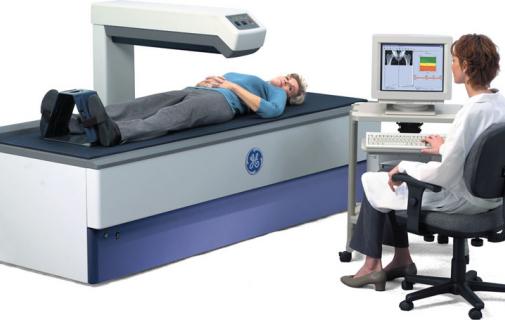
Vizuālā diagnostika Ltd. offers osteodensitometry or dual X-Ray absorptiometry (DXA) examinations, by providing the patients with the opportunity to promptly diagnose the changes in bone density. The use of the advantages of contemporary and developed technology, Vizuālā diagnostika ensures high quality service to its patients, thus taking care of the patient at every phase of examination.
DXA is an examination for the determining of bone mineral density, during which the patient is scanned with X-Rays, while a special computer software immediately calculates mineral density of the bone. Osteodensitometry examinations enable quantitative determination of the decline in bone density, which could point to the development of osteoporosis.
DXA examination is safe and painless for the patient. The ionising radiation that the patient is exposed to is minimal.
The company of Veselības centrs 4 group Vizuālā diagnostika Ltd. can perform osteodensitometry examination in patients, who have reached the age of 21, as well as patients, whose body mass does not exceed 140 kg.
- Who are recommended to perform DXA examination?
Adults
- Women after the age of 65;
- Women during menopause, if risk factors of fracturing exist (for instance, decreased body mass index, a history of “bristle bone” fracture, etc.)
- Men after the age of 70;
- Men prior to the age of 70, if risk factors of fracturing exist (for instance, decreased body mass index, a history of “bristle bone” fracture, etc.)
- Adults, who have sustained bone fractures in the event of minimal trauma;
- Adults, who have a disease or a health condition that is associated with reduced bone mass or loss of bone tissue, or who use medications associated with reduced bone mass or loss of bone tissue;
- Any patient prior to the commencement of specific osteoporosis therapy or after therapy to assess the effect caused by the therapy;
- Any patient, who has encountered rapid loss of bone mass (for instance, as a result of glucocorticoid use);
- Women, who have discontinued hormone replacement therapy (HRT);
- Any patient, who is not treated, but who would receive therapy, if the loss of bone mass is detected.
Children
- After long term (>1 year), systemic use of glucocorticoids;
- In the event of a chronic inflammatory disease (for instance, Crohn's disease, coeliac disease, ulcers, arthritis, systemic lupus erythematosus, dermatomyositis and other systemic diseases);
- In the event of hypogonadism;
- In the event of long-term immobilisation (>2 months);
- In the event of repeated fractures caused by minor trauma;
- If osteopenia is detected in a traditional radiological examination.




